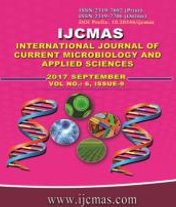


 National Academy of Agricultural Sciences (NAAS)
National Academy of Agricultural Sciences (NAAS)

|
PRINT ISSN : 2319-7692
Online ISSN : 2319-7706 Issues : 12 per year Publisher : Excellent Publishers Email : editorijcmas@gmail.com / submit@ijcmas.com Editor-in-chief: Dr.M.Prakash Index Copernicus ICV 2018: 95.39 NAAS RATING 2020: 5.38 |
Pooled data of field experiment conducted at Organic Farm along with one control outside the organic farm revealed that among the different organics treatments O4 (33.3 % RDN through bio compost + 33.3 % RDN through vermi compost + 33.4 % RDN through castor cake) recorded significantly higher fruit dry matter yield (103.24 q/ha) of papaya as compared to other treatments. Like organics, sap effect was also significant and treatment S1 recorded significantly higher fruit dry matter yield (96.20 q/ha) in comparison to no application of sap (S0). In all the case, INM control recorded significantly higher values of petiole, leaves and fruit dry matter yield as compared to means of organics treatments. The N, P and K content in petiole, leaves and fruit of papaya were affected significantly due to individual effect of O except P and K content of petiole and leaves. Similarly, application of banana pseudostem sap S1 (with sap @ 8 l/plant) found significant in N, P and K content of petiole, leaves and fruit of papaya over no application of sap (S0) except P content in petiole. In case of control v/s rest analysis, mean of organics showed significant effect on N, P and K content of petiole, leaves and fruit of papaya. The magnitude of significance in uptake of N (14.39 kg/ha) and P (5.51 kg/ha) through petiole as well as N (17.78 kg/ha), P (2.50 kg/ha) and K (29.00 kg/ha) through fruit of papaya was found with treatment O4, however, it was at par with O3 with respect to N and P uptake by petiole. Application of banana pseudostem sap showed significantly higher uptake of N (14.49 and 17.17 kg/ha), P (5.16 and 2.31 kg/ha) and K (10.36 and 25.92 kg/ha) through leaves and fruit of papaya, respectively.
 |
 |
 |
 |
 |